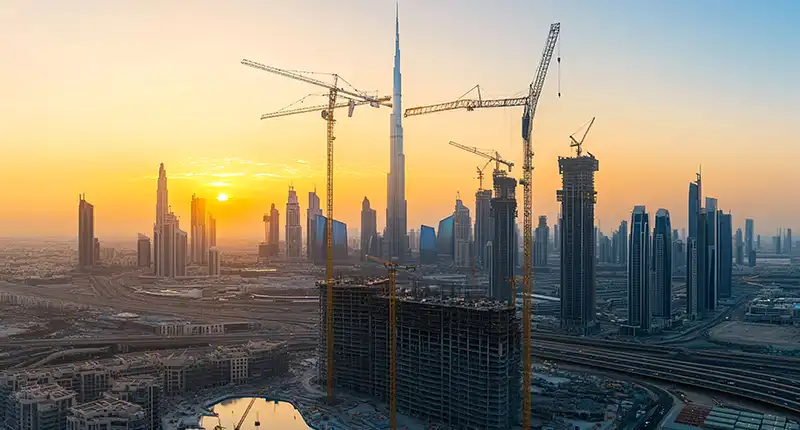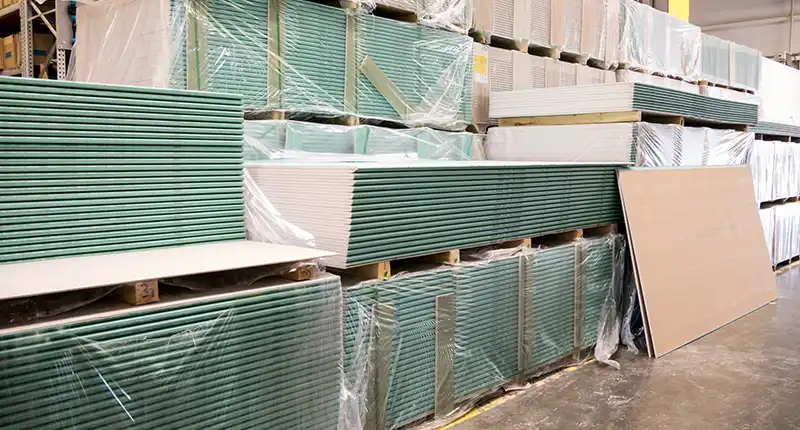
- New
- September 16, 2025
Fiber Cement Board as the Ideal Material for Modern Construction in the UAE
In the booming and competitive construction industry in the United Arab Emirates, the selection of building materials is of much interest, not only for its aesthetic value but also for its longer-term functionality, security, and sustainability. The high pace of urbanization within cities such as Dubai, Abu Dhabi, and Sharjah has necessitated innovations that could embrace the radical climatic conditions in the desert environment and at the same time support the international standards of architectural design.
Fiber cement board is one of the materials that has become leading in this shift. It is fire-resistant, durable, and has low maintenance; this has seen it replace the traditional gypsum, plywood, and metal sheets. More to the point, it also complies with the UAE’s efforts to make the construction sector more environmentally friendly and sustainable.
This blog will address why this product is deemed perfect in contemporary UAE projects, its contribution to the increase in urbanisation, how it performs in a desert climate, its expansion in the market, and how the main vendors are using it.
At a Glance
- 1. Unmatched Durability in a Harsh Climate
- 2. Superior Fire Resistance for Enhanced Safety
- 3. Excellent Resistance to Moisture and Humidity
- 4. Versatility in Design and Application
- 5. A Commitment to Sustainable Construction
- Conclusion: Building for a Resilient Futurem
- Building with Confidence in the UAE
- Frequently Asked Questions (FAQs)
UAE’s Rapid Construction Growth and Material Demands
The UAE has experienced rapid change in its urbanization over the past two decades, which has made it one of the fastest-changing cities globally. This growth is more evident in the form of mega-projects in infrastructure like the Burj Khalifa, Expo 2020 Dubai site, Yas Island, and grand plans related to housing. Such a degree of development demands materials that fulfill many of these criteria at once: strength, low weight, architectural elegance, and environmental sensitivity.
Such challenging environments are prone to fail the conventional building options. Wood, for example, becomes warped in damp conditions, and untreated metal rusts; gypsum is not strong enough to be used on the outside. Compared, however, to engineered composites like fiber cement panels, luxury projects and mass housing alike require the durability and versatility that they provide.
Sustainability is no longer an afterthought in terms of functionality. The UAE developers are also following the worldwide shift to green building standards (e.g., Estidama and LEED) that require smaller carbon prints and the use of recyclable materials. Fiber cement products, which are a combination of cement, cellulose fibers, sand, and water, obviously gain brownie points on this front.
Advantages of Fiber Cement Panels in Harsh Desert Conditions
Desert regions experience high temperatures during the day, often exceeding 40°C (104°F), and significantly cooler temperatures at night. Building materials must withstand these temperature fluctuations without degrading.
Periodic rains and coastal humidity further contribute to the tension of construction materials. That is why durability is not an extra product feature, but a critical one.
Fiber cement-based panels are developed with the specific purpose of performing in such extremes. Their major benefits are:
- Weather resistance: They do not rot, shrink, or cause excessive expansion to ensure that they maintain their dimensions even after numerous years of existing under harsh desert sun.
- Fire safety: They are non-combustible and fulfill stronger fire codes, as well as being less prone to risk associated with residential and commercial development environments. This renders them very useful in schools, high-rise towers, and health care.
- Moisture: These boards do not tend to absorb water too much, unlike wood or low-quality composites, thus they resist mold and decay.
- Thermal performance: They do not lose form or composition during fast changes in temperature between the day and night, thus avoiding cracking.
- Economic preservation: Long-term maintenance expenses in the lifespan of the building are substantially reduced by its endurance- a key issue when considering housing authorities and investors.
- Eco-friendly: The fact that their ingredients are recyclable and non-toxic aligns with the sustainable objectives in the UAE.
Industry research proves that these panels can still perform reliably for 30 to 50 years in the desert environment with minimum maintenance. This makes them an asset, unlike an expense.

Applications and Projects in the UAE Market Growth
The Middle East & Africa fiber cement board market is projected to generate a revenue of $2,399.7 million by 2030, with a compound annual growth rate of 14.1%. The UAE driving adoption applications are:
- Wall cladding: Ideal to build high-value commercial towers and villas as it offers smooth finishing and can be put to use in extreme weather conditions.
- Partitions: In contemporary workplaces, partitions are commonly seen, requiring versatile and robust partitions.
- Ceilings: Using lightweight panels that can be used in places where water is likely to be used, such as kitchens or washrooms.
- External facades: Such fabric could preserve its looks and durability under such effects as sand abrasion and wind exposure.
- Floor substrates: Such that they serve as stable and moisture-resistant underlays on tiles or carpets.
Surprisingly, high-density fiber cement boards dominate the market revenue of the region to an extent exceeding 60%, due to their excellent property of load-bearing and energy-resistant impacts.
The Fiber Cement Board Market, valued at USD 523.32 million in 2024, is projected to reach USD 720.65 million by 2030 at a CAGR of 5.32%. This implies that the high-speed growth of the UAE is similar to a global trend that prefers using sustainable materials.
Leading Suppliers and Notable UAE Deployments
Fiber cement solutions have regional and international suppliers who support fiber cement solutions adoption in the UAE since they are aware of the local market needs. Notable players would include:
- Gemini Building Materials: GBM, established in 1995, aims to become the leading distributor of building materials in the United Arab Emirates, Oman, and Kuwait. They are a leading distributor of building materials in the Gulf Cooperation Council, offering comprehensive services from supply to execution, renowned for its commitment to quality, innovation, and client satisfaction.
- Geminite : Geminite (Gemini Group) is the first and only Cellulose Fiber Cement Board Manufacturer based in Abu Dhabi, UAE. They are committed to manufacturing environmentally friendly Cement Fiber Boards and related products, using state-of-the-art plant machinery and equipment.
- SCG Smartboard (Lumber World UAE Distributor): SCG is the exclusive distributor of SCG Cement Boards in the UAE and Middle East market, offering durability, versatility, and easy installation for indoor and outdoor applications. These moisture-resistant, termite-proof boards are ideal for construction and renovation projects.
- Everest Industries Ltd: Everest Industries Ltd., established in 1934, is a leading supplier of building materials to architects, designers, and engineers. They offer a diverse portfolio of roofing, ceiling, wall, flooring, and cladding solutions, as well as pre-engineered steel buildings for industrial, commercial, and residential needs.
Case studies explain their flexibility. In high-quality Dubai villa projects, cladding panels provide smooth finishes and have low maintenance. The fire-rated properties of these boards are beneficial in terms of safety standards in schools and hospitals in Abu Dhabi. Meanwhile, low maintenance and cost-efficiency on labor camp housing and staff lodgings offer the highest returns to developers.
Why Choose Fiber Cement Over Conventional Alternatives?
When selecting building materials, strength, safety, and long-term value are top priorities. Fiber cement stands out because it offers advantages that traditional options like plywood, gypsum, and metal often cannot match. When compared to substitutes, the decision is easier to make:
- Compared to Plywood: Fiber cement is superior in moist and coastal areas, and it does not warp, swell, or harbor termites.
- Compared to Gypsum: More sturdy and better in general- more adaptable and can be used even outside, where gypsum would have been damaged.
- Compared to Metal Sheets: Corrosion and dent problems are free, and it is more aesthetically adjustable.
The construction market of the UAE is taking a new step towards a new era, with a certain focus on resilience, architectural elegance, and environmentally friendly approach. Such materials as fiber cement boards reflect this trend, which presents durability in the context of desert conditions, fire-safety compliance, and sustainability.
It is more than material to architects, developers, and contractors; it is a philosophy of edges that expresses modern buildings: build once, build strong, sustainably. Its contribution to the skyline of the UAE is indubitable, whether it is in the luxurious high-rise buildings or affordable housing.
FAQ’s
- What is fiber cement board made of?
Fiber cement board is manufactured by combining cement, cellulose fibers, sand, and water. This composition makes it both durable and versatile, suitable for walls, ceilings, partitions, and facades.
- Why is fiber cement board suitable for the UAE climate?
The UAE has extreme heat, sandstorms, and occasional humidity. Fiber cement resists these challenges—it doesn’t warp, swell, or decay, and remains stable even under intense desert conditions.
- How long can fiber cement boards last in construction projects?
With proper installation, it can serve effectively for 30–50 years, even in desert environments. Its longevity makes it a cost-efficient choice compared to many conventional materials.
- Is fiber cement board eco-friendly?
Yes. It uses natural and recyclable raw materials, lowering the carbon footprint of construction projects. This aligns with the UAE’s focus on green building practices and sustainable development.
- Where is fiber cement board commonly used in UAE projects?
It is widely used in wall cladding, ceilings, room partitions, external facades, and floor underlays. Its flexibility makes it popular in both high-rise towers and residential villas.